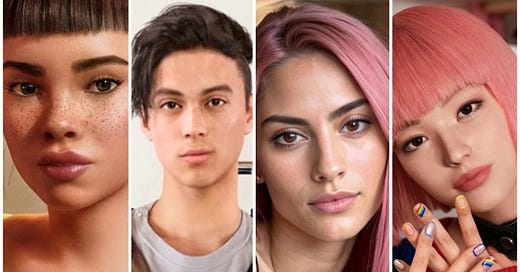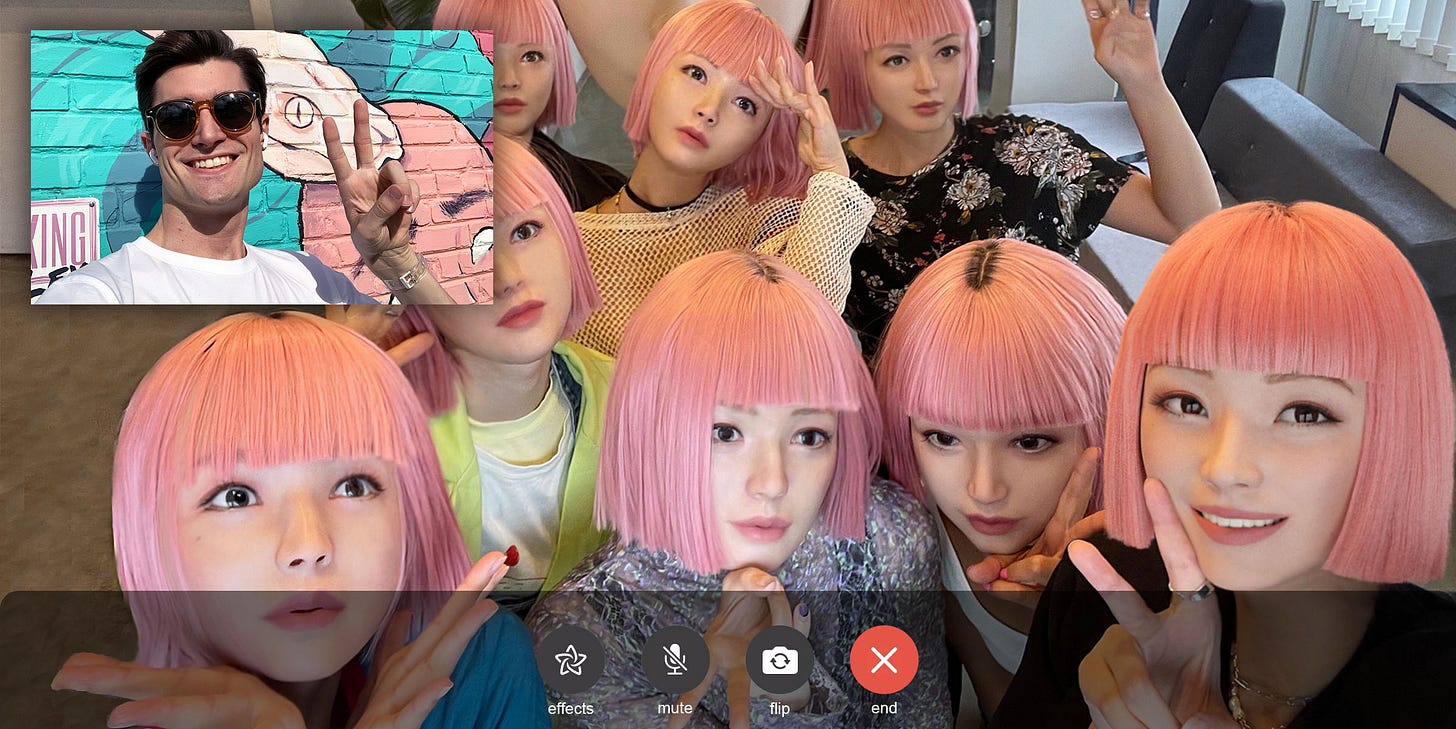Look at this post:
As you may have deduced, Aitana Lopez is a virtual influencer generated via artificial intelligence (AI) technology by a Spanish ad agency. She can earn up to €10,000 a month, with an average around €3,000. Designers use tools such as Photoshop to create Aitana’s new journey every week as if she is actually traveling.
I agree with the comment here - the tech is surely “improving every day.”
We should expect even more AI-related headlines and developments this year. The IMF predicts that as of 2024, AI will impact about 40% of human global jobs. Of those, I focus here on the influencer - we’re still in the relatively early phases, but established brands have already partnered with virtual, rather than human, influencers for endorsement deals.
In recent years, we’ve seen a rapid growth content creation and the subsequent monetization - the ecosystem known as the “creator economy” - with a projected estimate of $480 billion by 2027. It’s worth keeping an eye on how virtual influencers take part in light of technological developments.
Anyways here’s Rozy, from South Korean company Sidus Studio X:
The Rise & Considerations
See the Bella Hadid & Lil Miquela 2019 campaign for CK above, which was criticized for queerbaiting.
I think there’s a couple of factors to consider for the rise of virtual influencers:
General tech advancements - Virtual characters and avatars have existed for decades (Ex: Hatsune Miku, who’s already held numerous live concerts and was featured in over 100,000 songs). Not all virtual influencers involve AI, but it is certainly playing a larger role as with recent campaigns featuring Aitana and Lil Miquela.
Covid-19/Remote - Perhaps the lack of human contact forced brands to consider alternative advertising strategies. There’s no statistic that exemplifies this and campaigns don’t always require the talent to be on set. However, consider the emphasis placed on remote work in the past few years.
Growing creator economy - Only recently has mainstream attention focused on both “AI” and “influencers”, both separately and together. Influencer marketing is a proven strategy via content creation.
Web3/Metaverse - Despite the waning public interest in this space, Meta had invested heavily in the Metaverse Avatars for VR compatibility. There is still a lot of crossover potential here, depending on when the next breakthrough is.
But the real focus here - Why choose a virtual human over a real one?
Pros:
Costs - Reduce the need to re-negotiate every time. Influencers generally charge per post (photo/video) based on their following on a tiered basis.1 Lil Miquela charges only $9,000 per post, and Chinese tech company Baidu charges $14,300 per year for a ‘virtual person’ project. Not bad compared to how expensive it is to cast a celebrity or a high-profile influencer.
Engagement - Humans have long been fascinated by the idea of robots taking over in a rebellion or apocalypse scenario. A post from a virtual influencer instantly garners attention and engagement in the comments. Since marketing and advertising are metrics-based, strategies can be modified more smoothly compared to if a human influencer were involved.
Public Relations (PR) - The virtual influencer is relatively freer from PR concerns surrounding its personal life or identity as everything is already fabricated. If anything, the virtual influencer ‘follows directions every time’ and mitigates the need for immediate crisis responses. See the Bud Light transgender backlash or the SHEIN influencers’ China trip PR crises.
Exclusivity & Ubiquity - The virtual influencer exist in multiple ‘places’ at once, opening up creative possibilities for content. However, non-competes should be expected; it would be impractical for Aitana, for example, to simultaneously promote both Coca-Cola and Pepsi in succession.
Cons:
Small pool - There’s a lot of human influencers, but not as many notable robots yet. However, that is TBA as more agencies will create and design virtual influencers as we speak.
Authenticity - We are often drawn to marketing campaigns that we can easily relate to, such as everyday items or those featuring ordinary people (or in reverse, celebrities/influencers that we ‘idolize’). The virtual influencer campaign requires a bit of suspension of disbelief and/or imagination on our part, unless the design and presentation are hyperrealistic.
Elimination of human labor - Despite how you may feel towards influencer culture, this is just another example of AI taking over human jobs. Should we be worried? I don’t know, we’ll find out.
Projection - Interestingly enough, most of the well-known virtual influencers are often diverse females that project images of progression and inclusivity. Further, current virtual influencers are carefully designed, provoking unrealistic beauty expectations of real humans (see backlash to Pacsun’s campaign with Lil Miquela) or sexualization. While I think there is ample room for the creation of more diverse characters, much of the developments may hinge on further normalizing the integration of AI for marketing and advertising.
The Rules
For starters in the U.S., there is a bill called “AI Labeling Act of 2023” - requiring disclosures for AI-generated content - introduced in July 2023. The Federal Trade Commission (FTC)’s endorsement guidelines expanded the meaning of “endorser” to what “appears to be an individual, group, or institution.” Thus just as it’d do with a human, the campaign must disclose that there is a material connection between the virtual influencer and the brand.
In another example, India requires a more blatant connection: the Advertising Standards Council of India (ASCI) has actually included virtual influencers under the influencer advertising standards, requiring the disclosure “that the audience is not interacting with a real human being.”

We may also consider right of publicity issues in which the virtual influencer draws upon a real human’s name, image and likeness (NIL) without consent. Similar to the deepfake issues which are criminal offenses, there are valid concerns with human voices, videos, and photos being used in an AI algorithm to design the character itself. What also happens if the virtual influencer inadvertently infringes upon existing IP? The combination of AI and IP is a mind-boggling topic in itself.
I don’t feel a certain way about virtual influencers yet. I think we’re still at the stage where we aren’t ready to embrace certain technological advancements at the sake of human jobs. I realize public opinion as to the ‘influencer as a vocation’ is divided, so I’d like to first see more high-profile virtual influencer marketing strategies come to fruition.
The Blurred Lines
The virtual influencer idea has been integrated as an AI chatbot here:
Amouranth is a Twitch streamer who has gained much success on adult subscription services like Onlyfans. The AI chatbot draws from Amouranth’s personality and speech to create the illusory parasocial relationship. The tiered membership system ranges from $5.99 to $199/month.
Essentially, this blends both the human and the virtual for an entertainment experience. If there is a demand, then we can bet that AI chatbots will become a part of fandom cultivation in the years to come.
We continue to debate AI’s ethical considerations and the role AI should play at the sake of potentially displacing human counterparts. Ultimately AI is a tool and a supplement that can create virtual characters that lack humans’ sentience (for now…). I am particularly amused by the role it plays in building entertainment value, both within and beyond the social media context. I'm a bit more cautious when discussing AI topics for now, given the rapid developments in both technology and regulation, and the existing discourse surrounding them.
Virtual influencers, or virtual 'humans' generally, will continue to play bigger roles as we interact with technology and entertainment. However, it is up to humans to shape their direction, as ultimately, they’re a result of our technological advancements.
Thanks for reading this one.
Mentally, I’ve been busy this month balancing my professional & social goals for this year. I turn 30 in the summer and am curious what the next decade would look like for my career. Right now, these are the building blocks that will help me get to where I want to be.
I have also been working on another K-pop piece, to be cross-posted likely in February with another outlet.
I am always seeking inspiration and creative thoughts. Let me know if you want to bounce ideas back and forth.
There’s talk of users leaving Substack over its recent refusal to ban all pro-Nazi content. I haven’t decided as the controversy coincided with my arrival here, but am monitoring developments and peer writers.
See you soon!
-Wooseok Ki (Wooski)
Most influencers that we think of (50k-500k followers) charge from $500 - $5000 per Instagram post. TikTok rates are much higher as they require more creative work.






